João Correia
Evolutionary Optimization Trumps Adam Optimization on Embedding Space Exploration
Nov 05, 2025Abstract:Deep generative models, especially diffusion architectures, have transformed image generation; however, they are challenging to control and optimize for specific goals without expensive retraining. Embedding Space Exploration, especially with Evolutionary Algorithms (EAs), has been shown to be a promising method for optimizing image generation, particularly within Diffusion Models. Therefore, in this work, we study the performance of an evolutionary optimization method, namely Separable Covariance Matrix Adaptation Evolution Strategy (sep-CMA-ES), against the widely adopted Adaptive Moment Estimation (Adam), applied to Stable Diffusion XL Turbo's prompt embedding vector. The evaluation of images combines the LAION Aesthetic Predictor V2 with CLIPScore into a weighted fitness function, allowing flexible trade-offs between visual appeal and adherence to prompts. Experiments on a subset of the Parti Prompts (P2) dataset showcase that sep-CMA-ES consistently yields superior improvements in aesthetic and alignment metrics in comparison to Adam. Results indicate that the evolutionary method provides efficient, gradient-free optimization for diffusion models, enhancing controllability without the need for fine-tuning. This study emphasizes the potential of evolutionary methods for embedding space exploration of deep generative models and outlines future research directions.
Evolutionary algorithms meet self-supervised learning: a comprehensive survey
Apr 09, 2025Abstract:The number of studies that combine Evolutionary Machine Learning and self-supervised learning has been growing steadily in recent years. Evolutionary Machine Learning has been shown to help automate the design of machine learning algorithms and to lead to more reliable solutions. Self-supervised learning, on the other hand, has produced good results in learning useful features when labelled data is limited. This suggests that the combination of these two areas can help both in shaping evolutionary processes and in automating the design of deep neural networks, while also reducing the need for labelled data. Still, there are no detailed reviews that explain how Evolutionary Machine Learning and self-supervised learning can be used together. To help with this, we provide an overview of studies that bring these areas together. Based on this growing interest and the range of existing works, we suggest a new sub-area of research, which we call Evolutionary Self-Supervised Learning and introduce a taxonomy for it. Finally, we point out some of the main challenges and suggest directions for future research to help Evolutionary Self-Supervised Learning grow and mature as a field.
EDCA -- An Evolutionary Data-Centric AutoML Framework for Efficient Pipelines
Mar 06, 2025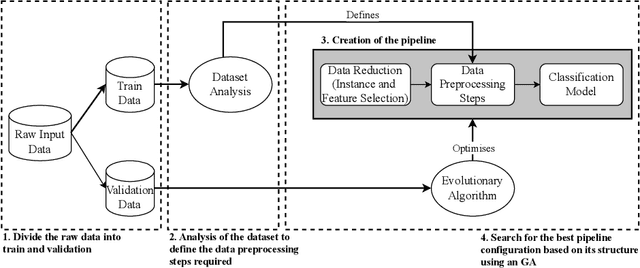
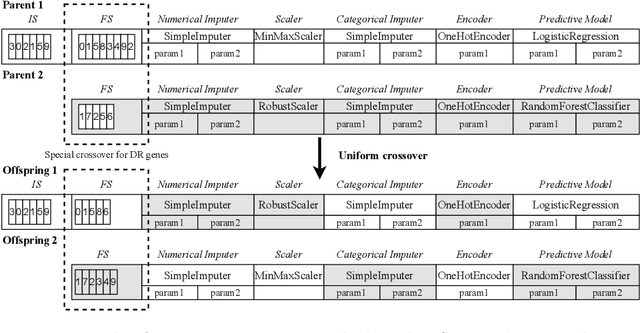
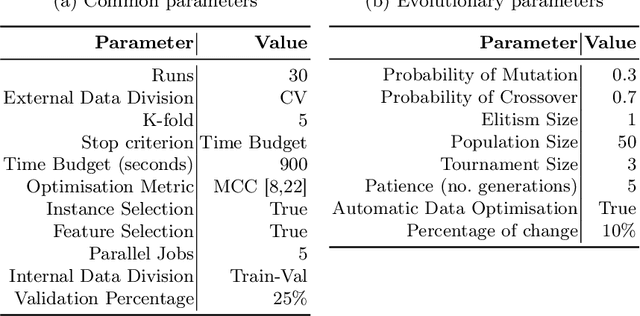

Abstract:Automated Machine Learning (AutoML) gained popularity due to the increased demand for Machine Learning (ML) specialists, allowing them to apply ML techniques effortlessly and quickly. AutoML implementations use optimisation methods to identify the most effective ML solution for a given dataset, aiming to improve one or more predefined metrics. However, most implementations focus on model selection and hyperparameter tuning. Despite being an important factor in obtaining high-performance ML systems, data quality is usually an overlooked part of AutoML and continues to be a manual and time-consuming task. This work presents EDCA, an Evolutionary Data Centric AutoML framework. In addition to the traditional tasks such as selecting the best models and hyperparameters, EDCA enhances the given data by optimising data processing tasks such as data reduction and cleaning according to the problems' needs. All these steps create an ML pipeline that is optimised by an evolutionary algorithm. To assess its effectiveness, EDCA was compared to FLAML and TPOT, two frameworks at the top of the AutoML benchmarks. The frameworks were evaluated in the same conditions using datasets from AMLB classification benchmarks. EDCA achieved statistically similar results in performance to FLAML and TPOT but used significantly less data to train the final solutions. Moreover, EDCA experimental results reveal that a good performance can be achieved using less data and efficient ML algorithm aspects that align with Green AutoML guidelines
Towards evolution of Deep Neural Networks through contrastive Self-Supervised learning
Jun 20, 2024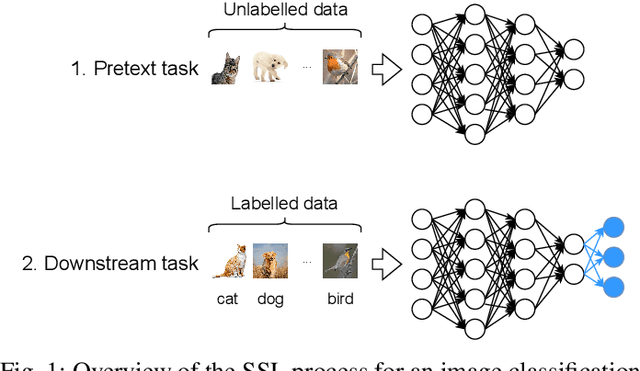
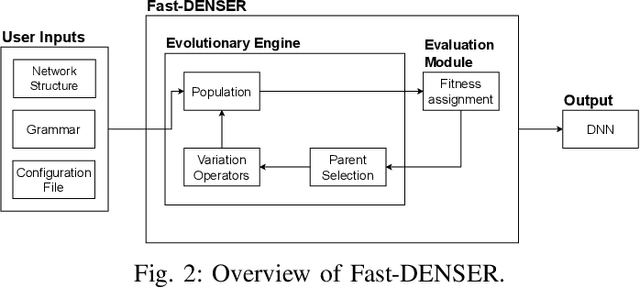
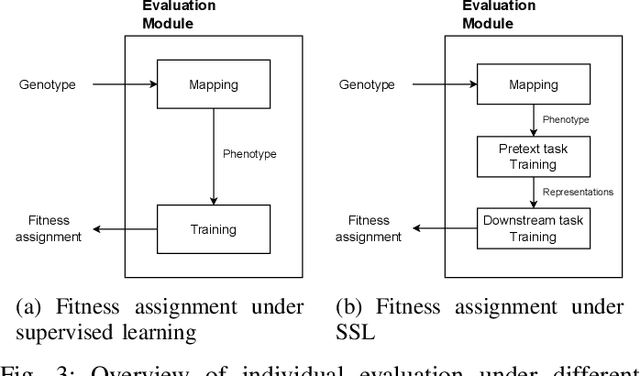
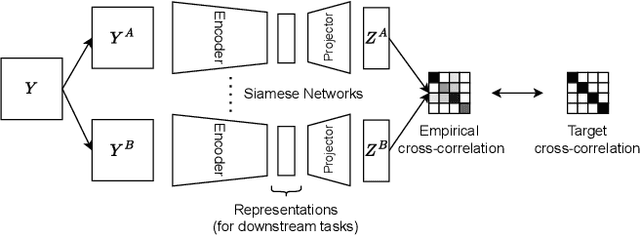
Abstract:Deep Neural Networks (DNNs) have been successfully applied to a wide range of problems. However, two main limitations are commonly pointed out. The first one is that they require long time to design. The other is that they heavily rely on labelled data, which can sometimes be costly and hard to obtain. In order to address the first problem, neuroevolution has been proved to be a plausible option to automate the design of DNNs. As for the second problem, self-supervised learning has been used to leverage unlabelled data to learn representations. Our goal is to study how neuroevolution can help self-supervised learning to bridge the gap to supervised learning in terms of performance. In this work, we propose a framework that is able to evolve deep neural networks using self-supervised learning. Our results on the CIFAR-10 dataset show that it is possible to evolve adequate neural networks while reducing the reliance on labelled data. Moreover, an analysis to the structure of the evolved networks suggests that the amount of labelled data fed to them has less effect on the structure of networks that learned via self-supervised learning, when compared to individuals that relied on supervised learning.
Automatic Design of Telecom Networks with Genetic Algorithms
Apr 02, 2023Abstract:With the increasing demand for high-quality internet services, deploying GPON/Fiber-to-the-Home networks is one of the biggest challenges that internet providers have to deal with due to the significant investments involved. Automated network design usage becomes more critical to aid with planning the network by minimising the costs of planning and deployment. The main objective is to tackle this problem of optimisation of networks that requires taking into account multiple factors such as the equipment placement and their configuration, the optimisation of the cable routes, the optimisation of the clients' allocation and other constraints involved in the minimisation problem. An AI-based solution is proposed to automate network design, which is a task typically done manually by teams of engineers. It is a difficult task requiring significant time to complete manually. To alleviate this tiresome task, we proposed a Genetic Algorithm using a two-level representation to design the networks automatically. To validate the approach, we compare the quality of the generated solutions with the handmade design ones that are deployed in the real world. The results show that our method can save costs and time in finding suitable and better solutions than existing ones, indicating its potential as a support design tool of solutions for GPON/Fiber-to-the-Home networks. In concrete, in the two scenarios where we validate our proposal, our approach can cut costs by 31% and by 52.2%, respectively, when compared with existing handmade ones, showcasing and validating the potential of the proposed approach.
Reducing the Price of Stable Cable Stayed Bridges with CMA-ES
Apr 02, 2023
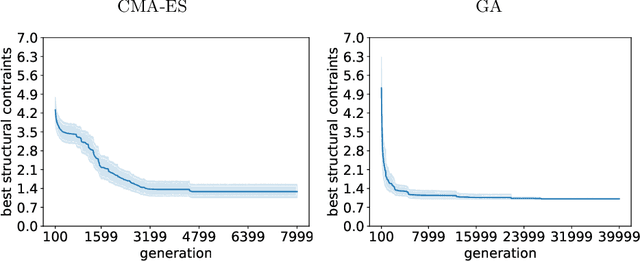
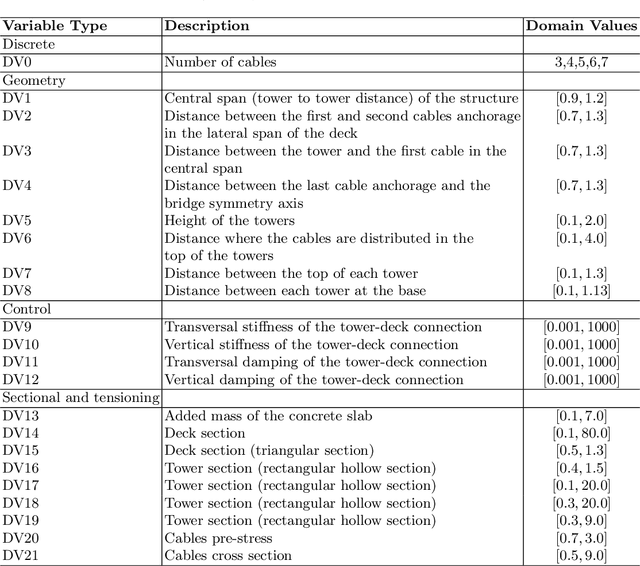
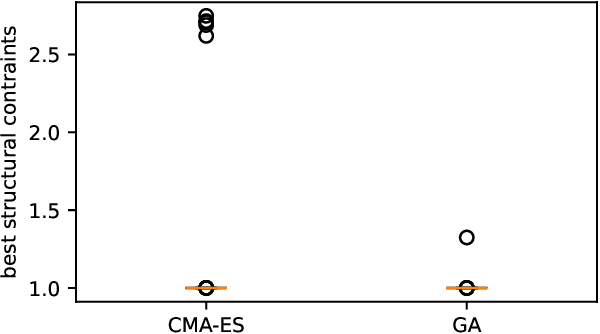
Abstract:The design of cable-stayed bridges requires the determination of several design variables' values. Civil engineers usually perform this task by hand as an iteration of steps that stops when the engineer is happy with both the cost and maintaining the structural constraints of the solution. The problem's difficulty arises from the fact that changing a variable may affect other variables, meaning that they are not independent, suggesting that we are facing a deceptive landscape. In this work, we compare two approaches to a baseline solution: a Genetic Algorithm and a CMA-ES algorithm. There are two objectives when designing the bridges: minimizing the cost and maintaining the structural constraints in acceptable values to be considered safe. These are conflicting objectives, meaning that decreasing the cost often results in a bridge that is not structurally safe. The results suggest that CMA-ES is a better option for finding good solutions in the search space, beating the baseline with the same amount of evaluations, while the Genetic Algorithm could not. In concrete, the CMA-ES approach is able to design bridges that are cheaper and structurally safe.
Exploring Generative Adversarial Networks for Text-to-Image Generation with Evolution Strategies
Jul 06, 2022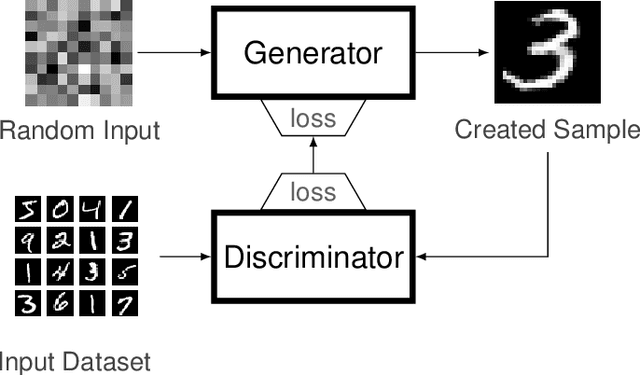
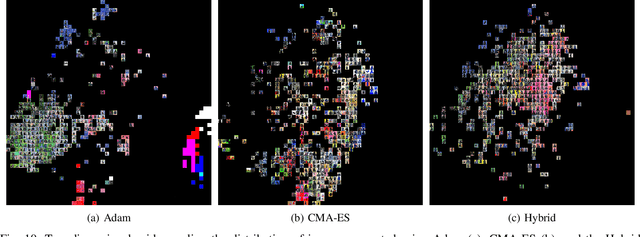
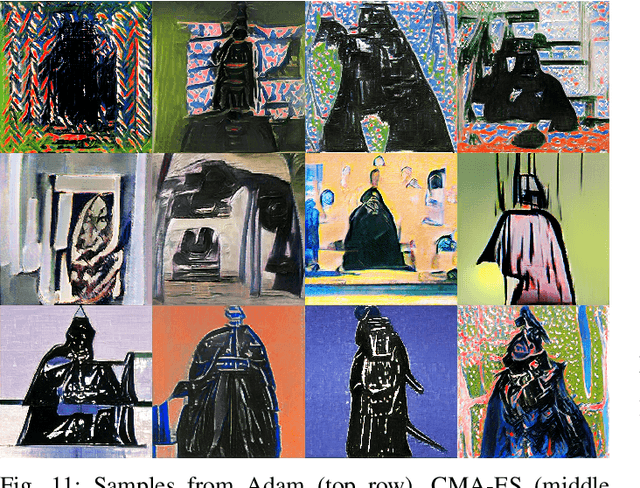
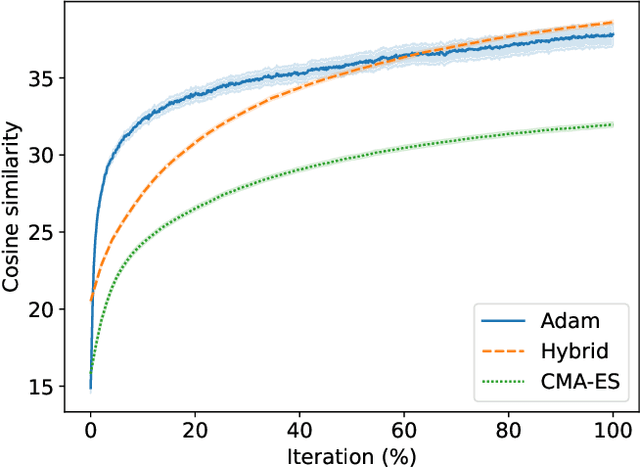
Abstract:In the context of generative models, text-to-image generation achieved impressive results in recent years. Models using different approaches were proposed and trained in huge datasets of pairs of texts and images. However, some methods rely on pre-trained models such as Generative Adversarial Networks, searching through the latent space of the generative model by using a gradient-based approach to update the latent vector, relying on loss functions such as the cosine similarity. In this work, we follow a different direction by proposing the use of Covariance Matrix Adaptation Evolution Strategy to explore the latent space of Generative Adversarial Networks. We compare this approach to the one using Adam and a hybrid strategy. We design an experimental study to compare the three approaches using different text inputs for image generation by adapting an evaluation method based on the projection of the resulting samples into a two-dimensional grid to inspect the diversity of the distributions. The results evidence that the evolutionary method achieves more diversity in the generation of samples, exploring different regions of the resulting grids. Besides, we show that the hybrid method combines the explored areas of the gradient-based and evolutionary approaches, leveraging the quality of the results.
TensorGP -- Genetic Programming Engine in TensorFlow
Mar 12, 2021
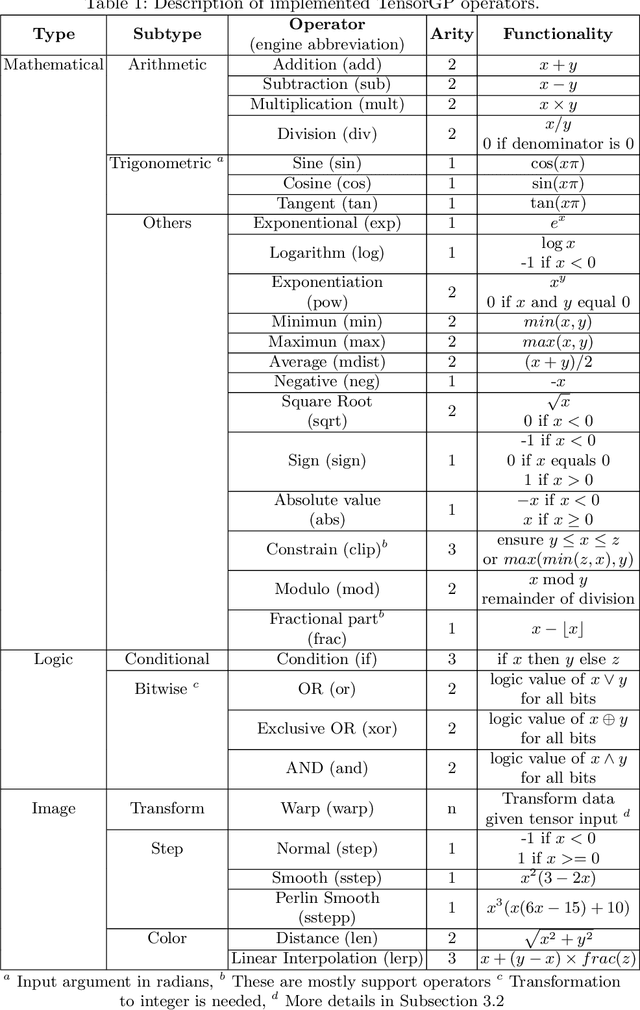
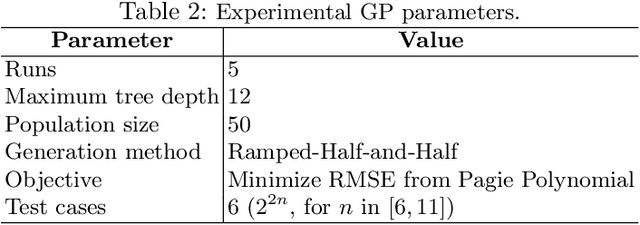
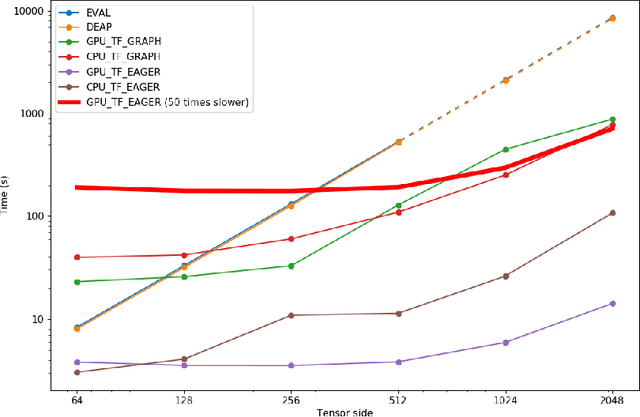
Abstract:In this paper, we resort to the TensorFlow framework to investigate the benefits of applying data vectorization and fitness caching methods to domain evaluation in Genetic Programming. For this purpose, an independent engine was developed, TensorGP, along with a testing suite to extract comparative timing results across different architectures and amongst both iterative and vectorized approaches. Our performance benchmarks demonstrate that by exploiting the TensorFlow eager execution model, performance gains of up to two orders of magnitude can be achieved on a parallel approach running on dedicated hardware when compared to a standard iterative approach.
Demonstrating the Evolution of GANs through t-SNE
Feb 25, 2021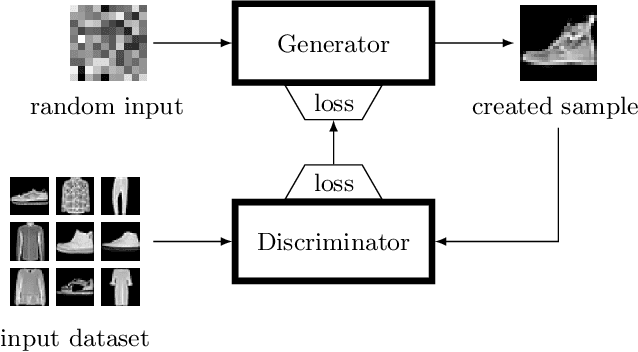
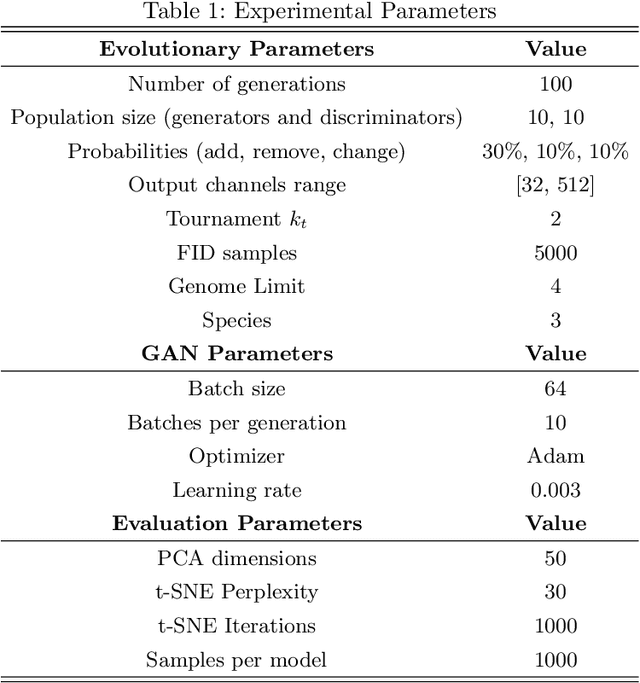
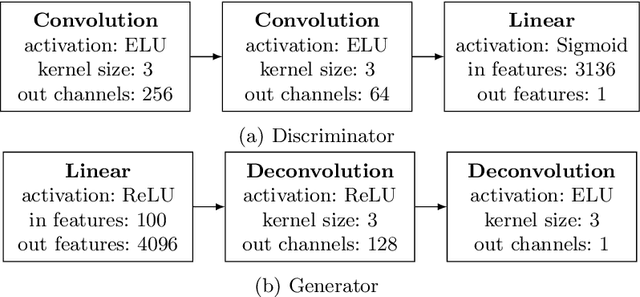
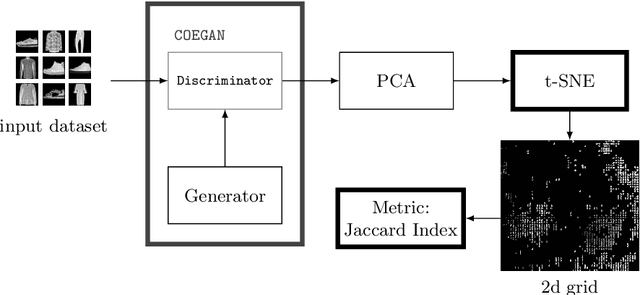
Abstract:Generative Adversarial Networks (GANs) are powerful generative models that achieved strong results, mainly in the image domain. However, the training of GANs is not trivial, presenting some challenges tackled by different strategies. Evolutionary algorithms, such as COEGAN, were recently proposed as a solution to improve the GAN training, overcoming common problems that affect the model, such as vanishing gradient and mode collapse. In this work, we propose an evaluation method based on t-distributed Stochastic Neighbour Embedding (t-SNE) to assess the progress of GANs and visualize the distribution learned by generators in training. We propose the use of the feature space extracted from trained discriminators to evaluate samples produced by generators and from the input dataset. A metric based on the resulting t-SNE maps and the Jaccard index is proposed to represent the model quality. Experiments were conducted to assess the progress of GANs when trained using COEGAN. The results show both by visual inspection and metrics that the Evolutionary Algorithm gradually improves discriminators and generators through generations, avoiding problems such as mode collapse.
Exploring the Evolution of GANs through Quality Diversity
Jul 13, 2020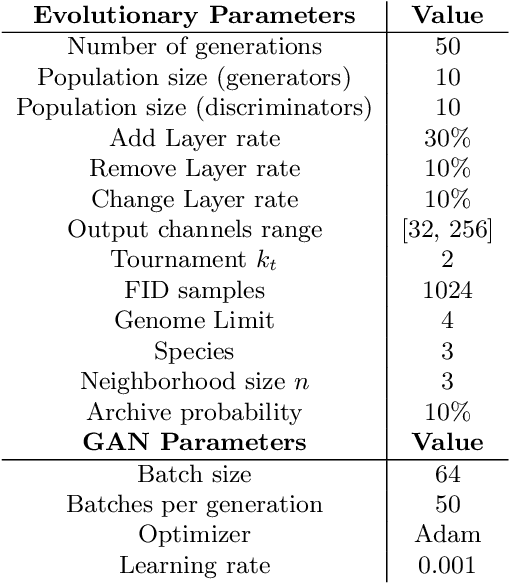
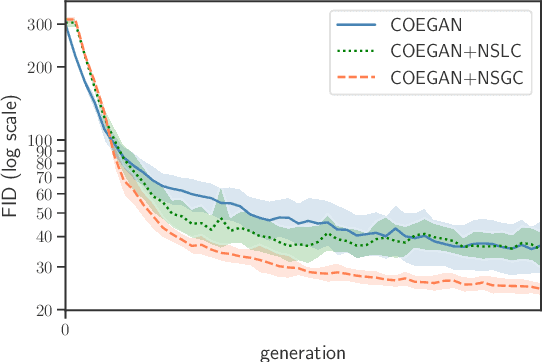
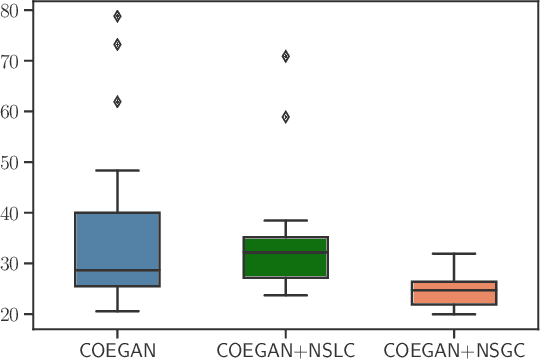
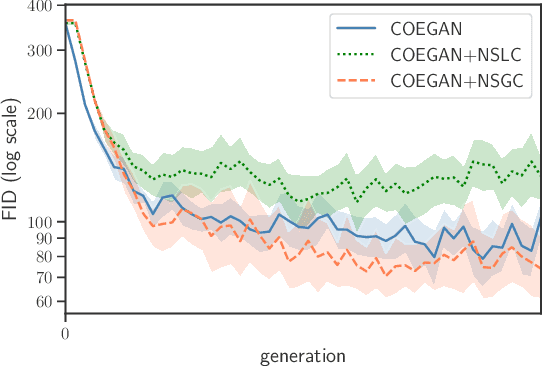
Abstract:Generative adversarial networks (GANs) achieved relevant advances in the field of generative algorithms, presenting high-quality results mainly in the context of images. However, GANs are hard to train, and several aspects of the model should be previously designed by hand to ensure training success. In this context, evolutionary algorithms such as COEGAN were proposed to solve the challenges in GAN training. Nevertheless, the lack of diversity and premature optimization can be found in some of these solutions. We propose in this paper the application of a quality-diversity algorithm in the evolution of GANs. The solution is based on the Novelty Search with Local Competition (NSLC) algorithm, adapting the concepts used in COEGAN to this new proposal. We compare our proposal with the original COEGAN model and with an alternative version using a global competition approach. The experimental results evidenced that our proposal increases the diversity of the discovered solutions and leverage the performance of the models found by the algorithm. Furthermore, the global competition approach was able to consistently find better models for GANs.
 Add to Chrome
Add to Chrome Add to Firefox
Add to Firefox Add to Edge
Add to Edge